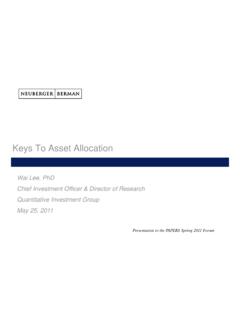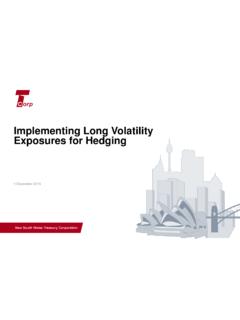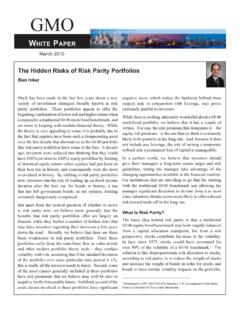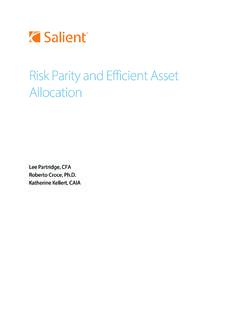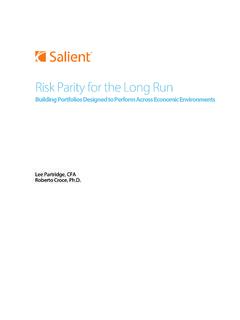Transcription of How Risk Parity Can Cope with Rising Rates - bvai.de
1 HAKAN KAYA, PhDSenior Portfolio Manager Quantitative and Multi-Asset ClassHow Risk Parity Can Cope with Rising RatesSEPTEMBER 2018| White paper |Because risk Parity strategies are often mischaracterized as leveraged bonds, many investors assume that they are destined to perform poorly when inflation, interest Rates or bond yields are Rising . However, whereas leveraged bonds implies a concentration in one risk factor, risk Parity is all about balancing risk factors to achieve genuine diversification before using leverage to attain a required overall risk or return objective.
2 In this paper , we show that a simple model of a three-asset-class risk Parity strategy generated positive returns, and outperformed a traditional 60/40 portfolio, during the late 1960s and 1970s, when inflation and Rates were Rising . We believe that in almost all economic environments, well-diversified risk Parity strategies can be robust and can be used to improve portfolio RISK Parity CAN COPE WITH Rising Rates 2 Executive Summary We explore two reasons for the positive performance of a model risk Parity strategy during a period of Rising inflation and interest Rates : the resilience of bond returns and the power of diversification.
3 Bond risk is more prominent in risk Parity strategies than in 60/40 portfolios, but bonds can generate a positive total return when yields are Rising as long as they do not rise too far or too rapidly. At the same time, bonds tend to perform strongly during periods of large losses in equities, delivering a powerful diversification benefit that helps to limit portfolio drawdowns and increase long-term compound returns. Adding commodities to a risk Parity portfolio can further strengthen these diversification benefits: since 1960, when equities experienced their worst losses, bonds posted good positive returns, and sometimes commodities helped, too; when commodities performed most poorly, bonds were positive, and sometimes equities helped, too.
4 We look at how a variety of risks short- and long-dated interest Rates , inflation, real interest Rates and business activity affect the model strategy compared with the 60/40 portfolio. Negative total returns to risk Parity tend to occur only when interest Rates and bond yields are exceptionally high or Rising very rapidly, or when business activity is exceptionally depressed. The risk Parity model tended to lag the 60/40 when real yields were Rising and business activity was expanding exceptionally rapidly during recoveries from recessions but even then, it still generally generated a positive return.
5 The 60/40 portfolio tended to deliver negative total returns in a larger number of scenarios: when short Rates were very high and long Rates were Rising rapidly; when inflation was Rising rapidly and when real yields were low or declining rapidly; and when business activity was depressed and contracting rapidly. Periods of outperformance over the risk Parity model strategy were rare. Overall, the risk Parity model exhibits slightly more frequent but much lower drawdowns than the 60/40 Portfolio Drawdown MagnitudeModel Risk Parity Drawdown Magnitude-10%-5%0%Dots on this side of the line show drawdowns in which risk Parity OUTPERFORMED 60/40 Dots on this side of the line show drawdowns in which risk Parity UNDERPERFORMED 60/40 Regression LineImprovement:RP vs.
6 60/40 RISK Parity CAN HELP TAME LARGE DRAWDOWNSEach dot shows the decline experienced by the two strategies in each drawdown between January 1963 and June 2018 Source: Ibbotson Associates, Neuberger Berman. HOW RISK Parity CAN COPE WITH Rising Rates 3 Whenever it appears that interest Rates are Rising , commentators warn of the reckoning that awaits risk Parity investors. That is understandable. In essence, risk Parity is an approach to portfolio construction that attempts to get the most possible benefit from the diversifying characteristics of different asset classes by weighting them so that their contribution to the risk of a portfolio is roughly equal.
7 It can define risk simply as volatility, or with some more sophisticated measure or combination of measures. Because equities tend to be riskier than bonds (two or three times riskier, in volatility terms), the performance of a capital allocation split equally between equities and bonds will be determined mainly by equity risk the bond characteristics will be largely drowned out. To get the benefit of the bonds, risk Parity investors add to the bond allocation until its risk contribution is equal to that of the equities.
8 To do that without compromising return expectations, however, it is necessary to leverage the resulting risk-balanced portfolio so that its overall exposure is greater than 100%, rather than simply switching some of the equity allocation for bonds. In this paper , when we build a model risk Parity strategy, we leverage the portfolio to reach a volatility target of 10% but once the risk Parity portfolio is constructed, it can be leveraged to any calibration of risk or return is why risk Parity is often characterized as leveraged bonds : because it involves adding more bonds and then leveraging the portfolio.
9 And if you think of risk Parity as leveraged bonds , Rising yields will seem like bad news. We argue that this is a mischaracterization. Risk Parity is not just leveraged bonds: it is a route to genuine multi-asset class diversification via the equalization of portfolio risk exposures. Moreover, most risk Parity approaches do not confine themselves to equities and bonds, but add asset classes such as credit and commodities, also with equalized risk contributions. In most environments of high or Rising yields, one or more of these other asset classes will perform well enough to balance negative performance of bonds.
10 Finally, Rising yields do not necessarily result in negative total returns to bonds losses occur only when yields rise further than bond market all of this together and we can begin to explain how risk Parity portfolios can generate positive returns during high and Rising -yield environments, as we will demonstrate in this article. We will show how a simple model risk Parity portfolio might have fared, relative to a traditional 60/40 portfolio, through a range of scenarios, and explain some of the dynamics behind that performance.
